|
Introduction
How to Use it
Latest release
Cool things to try out
Links
Registration
(troubles, questions, suggestions, comments)
 Back to AHo's Homepage Back to AHo's Homepage
|
Cool things to try out
On this page I describe some things that you can do with Planetarium. You are invited to do this step-by-step procedures with me and see if you get the same results.
Find the observation possibilities for today.
Let's assume, today were Aug, 22. 1998 and the night sky is going to be clear and we want to know if we should stay up for watching the planets. Let's further assume we are located at Chicago. So enter the following as Location and Timezone:
88.0°W, 42.0°N, GMT-6, DST on
Set the date to Aug, 22. 1998.
For a first survey, select Compass view and press the (R/S) button for a table of the rise and set times of the planets. We see that in the evening Jupiter and Saturn will rise. The other planets set early in the evening and will only be visible for a short time in the morning.
Set the time to 9:00 pm and make sure that in preferences all planets are switched on. We see that at this moment Jupiter is just above horizon. Set the time increment to 1 hour. Increment several times. You can see that the altitude of Jupiter is increasing with time and Saturn is following. At midnight both could be seen well. If you have a small telescope or binoculars, you could try to observe Jupiter's moons and Saturn's ring. You can also switch to Sky view and watch them crossing the eastern horizon line when you are stepping the time.time.
|

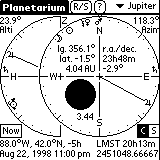
|
Determine sunrise and sunset
Let's find the time of sunrise and sunset on Aug, 22. 1998 in Boston. To do this, enter the following as Location and Timezone:
71.1°W, 42.3°N, GMT-5, DST on
Set the date to Aug, 22. 1998.
Choose Compass view and tap on the (R/S) button. After a few seconds the display will show all the relevant times concerning the Sun and twilight. Sunrise is at 5:59 am and sunset is at 7:35 pm. At the right there is a picture of Compass view at the time of sunset to verify it. Please note that sunrise and sunset are when the Sun has an altitude of -0.83°. One reason for this is that the Sun is not a point of light but a disk about 0.5° wide. The other reason is that the atmospheric refraction lets objects at the horizon appear slightly higher than they really are. Taking this into account, the top of the Sun's disk visually crosses the horizon line when it's center has an altitude of -0.83°.
If you are interested in the times of Moon rise and set, select the [Planets] button.
|
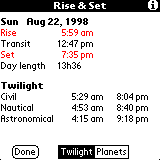
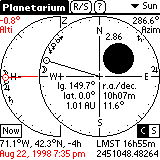
|
See the Moon's crescent lying horizontally near the equator.
When you live near the equator you can sometimes see the Moon lying horizontally like a smilie. This is rather an unfamiliar view for people living in higher latitudes. Enter the following as Location and Timezone:
36.0°E, 1.0°S, GMT+3, DST off (Nairobi)
Set the date to Apr 20. 1999 and the time to 10.00 pm. Choose Compass view and have a look at the Moon phase diagram. You can also select Sky view and see the Moon setting perfectly vertically when stepping hours.
|
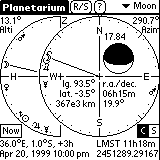 |
Verify the Sun eclipse at Aug 11. 1999 in southern Germany
Let's go to southern Germany. Enter the following as Location and Timezone:
10.0°E, 48.5°N, GMT+1, DST on
Set the date to Aug 11. 1999 and the time to 12.35 pm.
Both the Sun and the Moon are small disks on the sky of about 0.5° in diameter and they have to get really close for an eclipse to occur. Most of the new moons are not eclipses because the Moon's orbit is tiltet by about 5° to the plane of Earth's orbit and it passes either above or below the Sun. But on this specific day look at the azimuth and the altitude of the Sun (choose Compass view and set the selected planet to Sun) and compare it with the azimuth and the altitude of the Moon (set the selected planet to Moon). The are both 158.4° and 55.3° respectively, so they are very close. Because the accuracy of Planetarium is only 0.1°, we can not tell if this is a total or a partial eclipse, nor the exact contact times. But in fact it was a total one. And a totally clouded one, too...
|
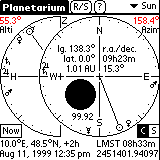
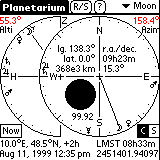
|
The Sun never sets in polar summer
Let's go to Inuvik (Canada): 134°W, 68°N, GMT-7, DST on
Set the date to June, 21. 1999. Now select Compass view and observe the altitude of the Sun as you step hour by hour through the day. It will not go below 1.4°.
|
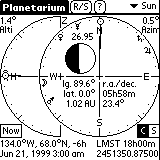 |
Find the Big Dipper and Polaris
If you live in northern hemispheres, enter your location and try to find the Big Dipper and Polaris in Sky view. You can use the search function for that, accessible by tapping the (?) button. Please note that the official name for Big Dipper is "Ursa Major".
|
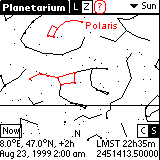 |
Observe a retrograde loop of a planet
Did you know that the early medieval astronomers had great difficulty in explaining the planetary motions? Let's see why.
Select 8°E, 47°N, GMT+1, DST off. Select Nov 28. 1998, 7:00 am. Select Sky view and make sure that in preferences Mars is switched on. Look horizontally in direction SE. You should see the Sun a few degrees below the horizon and Mars about 45° above. Set the time increment to 6.981 days or to 29.918 days if you have little time. Using one of these odd numbers has the advantage that the stars seem to stay at their place and we can watch the motion of the planet against them. Step now the time up and observe Mars wandering through the constellations. In March 1999 it will slow down and go back in April! This retrograde loop will last until June and then Mars will continue in the usual direction. Unfortunately it becomes harder then to observe Mars on the real sky because it is also getting closer to the Sun and therefore the sky will be too bright to see it.
|
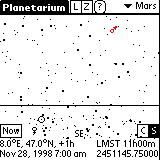 |
Determine the next full moon
Select 8°E, 47°N, GMT+1, DST on. Select Aug 22. 1998, 1:00 pm. When is the next full moon?
New moon has just passed. The percentage next to the Moon phase diagram shows 1.19%. Full moon will be at 50.00%. Set the time increment to 7 days. Step up until you get close to 50 (I got 46.16). Reduce now the time increment to 24 hours. Step up or down until you get as close to 50.00 as possible. Reduce the time increment further and refine the time. Proceed until you arrive at the desired accuracy. It is not possible to be more precise than 5 min with the accuracy offered by Planetarium, so I found the next full moon will be at Sept. 6, 1998 1:25 pm.
|
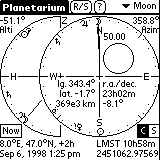 |
Use Planetarium as a compass
Enter your location and switch the Now-Button on. If the Sun is visible on a clear sky, turn the Palm Organizer so that the Sun symbol in the azimuth diagram points to the Sun. The aizmuth scale shows now the directions. Note that you do NOT need to correct for the declination between true and magnetic North pole! The azimuth scale points to the true North pole.
To get it more precisely, the Sun should cast a shadow of a vertical edge. Put the Palm Organizer on a flat even sunlit surface. This surface should be as horizontal as possible. Find a rectangular object like a cigarette box for example. Select Compass view and set the selected planet to Sun, so that you get a line drawn from the center in the azimuth diagram to the Sun symbol. Now move and turn the Palm Organizer so that this line is exactly aligned with the shadow of one of the vertical edges of the rectangular object.
LX200 Alignment stars
You can define your own list of objects in Planetarium. The following is a list of the 33 LX200 allignment stars. This list was contributed by Donald Winspear, Michael Boni and Allan Gould. They entered the data and checked/corrected it.
Just load the following text into the Palm Notepad as a single Memo and Planitarium can import it from there. Once you have the text as Memo, start Planetarium and select the menu item Options/Objects to go to the objects data base. Then tap the category selector at the upper right and choose "Edit Categories..." to create a new category named "LX200" or so. Make sure this category is selected, then use the menu item "Import from Memo" to import the memo with the title "Planetarium Objects LX200".
Planetarium Objects LX200
Achenar, *13;Eri, m0.5; 1h38m; -57:12'; 1; 4
Acrux A, *121;Cru, m1.3; 12h27m; -63:06'; 1; 4
Albireo, *223;Cyg, m3.1; 19h31m; 28:00'; 1; 4
Alcaid, *140;UMa, m1.9; 13h47m; 49:18'; 1; 4
Aldebaran, *33;Tau, m0.9; 4h36m; 16:30'; 1; 4
Alnilam, *50;Ori, m1.7; 5h36m; -1:12'; 1; 4
Alphard, *95;Hya, m2.0; 9h28m; -8:42'; 1; 4
Alphekka, *165;CrB, m2.2; 15h35m; 26:42'; 1; 4
Altair, *226;Aql, m0.8; 19h51m; 8:54'; 1; 4
Antares, *177;Sco, m0.9; 16h29m; -26:24'; 1; 4
Arcturus, *147;Boo, m0.0; 14h16m; 19:12'; 1; 4
Betelgeuse, *56;Ori, m0.4; 5h55m; 7:24'; 1; 4
Bogardus, *58;Aur, m2.6; 5h59m; 37:12'; 1; 4
Canopus, *63;Car, m-0.7; 6h24m; -52:42'; 1; 4
Capella, *42;Aur, m0.1; 5h17m; 46:00'; 1; 4
Castor A, *78;Gem, m1.9; 7h35m; 31:54'; 1; 4
Deneb, *232;Cyg, m1.3; 20h41m; 45:18'; 1; 4
Denebola, *114;Leo, m2.1; 11h49m; 14:36'; 1; 4
Diphda, *8;Cet, m2.0; 0h44m; -18:00'; 1; 4
Enif, *238;Peg, m2.4; 21h44m; 9:54'; 1; 4
Fomalhaut, *247;PsA, m1.2; 22h58m; -29:36'; 1; 4
Hadar, *144;Cen, m0.6; 14h04m; -60:24'; 1; 4
Hamal, *17;Ari, m2.0; 2h07m; 23:30'; 1; 4
Markab, *249;Peg, m2.5; 23h05m; 15:12'; 1; 4
Mira, *20;Cet, m2.1; 2h19m; -3:00'; 1; 4
Polaris, *19;Umi, m2.0; 2h34m; 89:18'; 1; 4
Pollux, *81;Gem, m1.1; 7h45m; 28:00'; 1; 4
Procyon, *80;CMi, m0.4; 7h39m; 5:12'; 1; 4
Regulus, *100;Leo, m1.4; 10h08m; 12:00'; 1; 4
Rigel, *41;Ori, m0.1; 5h15m; -8:12'; 1; 4
Sirius, *67;CMa, m-1.5; 6h45m; -16:42'; 1; 4
Spica, *138;Vir, m1.0; 13h25m; -11:12'; 1; 4
Vega, *214;Lyr, m0.0; 18h37m; 38:48'; 1; 4
|
Disclaimer:
The author of Planetarium can not be held responsible for star gazers falling asleep at their working place!
|

